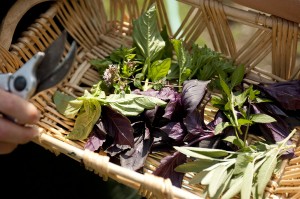Tip of the Week — 12/15/08
Posted in Gardening Tips on December 15 2008, by Sonia Uyterhoeven
Growing Herbs Indoors
 Sonia Uyterhoeven is Gardener for Public Education at The New York Botanical Garden.
Sonia Uyterhoeven is Gardener for Public Education at The New York Botanical Garden.
 As winter winds chill your bones, some of your summer pastimes can be successfully re-created in the home. One of my favorites is growing herbs on a windowsill. My biggest challenge is overuse. Healthy plants get nightly haircuts until they dwindle into a small patch of nothingness.
As winter winds chill your bones, some of your summer pastimes can be successfully re-created in the home. One of my favorites is growing herbs on a windowsill. My biggest challenge is overuse. Healthy plants get nightly haircuts until they dwindle into a small patch of nothingness.
For those of you who are able to exercise better restraint, many herbs can be grown indoors and will happily survive on a sunny windowsill. Basil, chives, parsley, thyme, and oregano are easy to grow. Rosemary is trickier to grow as it needs a cool room (around 60°F) and high humidity. Most herbs require six hours of sunlight to thrive. Bright southern or western exposure is best. Parsley, rosemary, and mint can take less light.
All herbs are unhappy with the dry, stagnant air common in homes during the winter months. Some antidotes: occasionally crack open a window or periodically run a small oscillating fan; keep household temperatures in the 70s; mist plants daily, place them on top of a pebble tray, or invest in a humidifier that will benefit both you and your green guests.
Use water at room temperature for herbs. Some such as marjoram, oregano, sage, and thyme need to dry out between watering—meaning when the soil surface is dry. Rosemary and mint will resent dry periods and shouldn’t be allowed to completely dry out. Make sure that water doesn’t collect or sit on the leaves of your herbs, otherwise they will rot. Basil is particularly susceptible.
Indoor herbs, like all of your houseplants, will gather dust and will require an occasional bath. Take a soft sponge or paper towel and clean the leaves. Alternatively, gently run it under the shower or the tap. While herbs don’t need fertilizing when they are growing outdoors, a monthly boost of half-strength fish emulsion will help keep your winter windowsill herbs thriving.
If the herbs are moving from outdoors to indoors they should be potted up before the first frost. If they undergo a reverse hardening off procedure they will have a better chance of adjusting to your home environment. Place the containers in a slightly shady area for a week to prepare them to the lower light levels of the home. Gradually bring them in for a few hours every day until you are ready to provide them with a new home.
When bringing your herbs indoors from the garden, many will benefit from being cut back by half. Some examples are rosemary, mint, sage, thyme and oregano. Remember that herbs love haircuts—it keeps the growth nice and tender and tasty. Growing herbs in your home is fairly easy; the hardest choices you will face is whether you should put them in your salad or on the roasted chicken.

